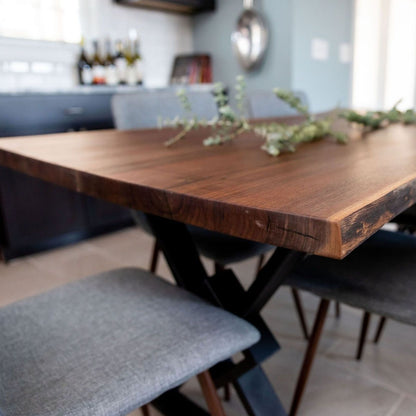Expert Tips for Setting Up Dining-room Table Legs for Optimum Stability
When it pertains to setting up eating room table legs, attaining optimum security is paramount for both performance and appearances. The procedure starts with selecting the ideal products and hardware, followed by careful positioning and factor to consider of weight distribution. Each action plays a crucial duty in making certain that the completed product endures day-to-day usage without compromising security or style honesty. Understanding the subtleties of these aspects can considerably affect the total result. What certain strategies can boost security even further?
Pick the Right Legs
When picking the ideal legs for your dining-room table, it is important to think about both performance and aesthetic appeals. The legs you choose will dramatically influence the overall design and stability of the table. Review the table's intended usage; if you anticipate frequent events, tougher legs, such as those made from solid timber or metal, might be a lot more appropriate, as they use enhanced resilience and support.
Next, take into consideration the elevation and style of the legs in regard to the tabletop. Standard dining tables normally vary from 28 to 30 inches in height, so make certain the legs line up with this standard for comfort. The design of the legs ought to match the design of the tabletop-- whether it be contemporary, rustic, or typical. Tapered legs can add a contemporary touch, while transformed legs may convey an extra traditional aesthetic.

Select Appropriate Equipment
How can the ideal hardware boost the stability and longevity of your dining-room table? The choice of appropriate hardware is important to making certain that the legs of your table are securely affixed and able to hold up against regular use. Premium screws, screws, and brackets give the needed strength to support the weight of the table, as well as any kind of additional lots placed upon it during dishes or events.
When selecting screws, decide for those made from long lasting materials such as stainless steel or brass, which resist rust and maintain stability with time. The length of the screws is equally essential; they should permeate deeply right into the table's framework without jeopardizing honesty. For bolted links, take into consideration utilizing lock washing machines to stop loosening due to vibration or motion.
Furthermore, using edge braces can include added assistance, specifically for bigger tables or those with much heavier tops. These braces distribute weight uniformly and assist maintain the table's shape. Ensuring that the hardware you select is ideal for the details products of your table will additionally improve its total security and longevity, permitting you to enjoy your dining experience for several years to come.
Ensure Correct Alignment
Appropriate placement of eating room table legs is vital for both aesthetic allure and practical security. To attain optimal alignment, start by determining the distance from the table's edges to the leg attachment points.
Use a level during installation to validate that each leg is perpendicular to Related Site the tabletop. It is recommended to mark the wanted leg positions on the underside of the table with a pencil or concealing tape before protecting them.
Additionally, double-check the alignment after the initial screws are tightened, as adjustments may be necessary prior to totally safeguarding the equipment. By focusing on proper alignment, you not only boost the table's general layout but also ensure that it remains stable and functional for several years to find.

Take Into Consideration Weight Circulation
After making certain proper placement of the eating space table legs, it is very important to think about weight distribution to improve security and functionality. dining room table legs. Appropriate weight distribution is essential in protecting against additional hints tottering and guaranteeing that the table can support its designated tons without risk of tipping or falling down
When positioning the legs, ensure they are positioned at equal ranges from the facility of the table to evenly disperse the weight throughout the structure. Take into consideration the weight of the tabletop and any products that will often relax on it, such as ornamental items or tabletop home appliances. Tables with much heavier surface areas should preferably have legs located closer to the corners, as this maximizes the base of support and minimizes the danger of instability.
Furthermore, if the table is planned for use in a high-traffic area, think about using larger materials for the legs or adding maintaining components, such as cross-bracing or a reduced shelf - dining room table legs. These changes can aid keep balance and protect against changing throughout usage. Inevitably, a well-considered weight circulation technique will considerably enhance the table's total performance, ensuring it continues to be a practical and eye-catching centerpiece for your eating room
Test Stability Prior To Use
Evaluating the security of the dining-room table before use is an essential action that should not be neglected. Making certain that the table is safe and secure can avoid accidents and extend the life-span of the furniture. Begin by applying mild pressure to various factors on the table surface area. Press down on the facility and then along the edges, moving or observing any kind of wobbling. Determine the legs or joints that may call for adjustment. if the table shows instability.
Next, check that all screws and bolts are tightened up properly. Loose links can result in instability and potential damage gradually. If needed, make use of timber glue on joints to enhance security, ensuring to allow adequate drying out time.

Final Thought
In final thought, the installment of dining-room table legs needs careful consideration of materials, hardware, weight, and positioning circulation to achieve optimum security. By selecting high-grade fasteners and sturdy legs, ensuring exact positioning, and dispersing weight equally, the structural stability of the table can be considerably improved. Conducting a stability test before routine use additionally guarantees that the table will certainly hold up against everyday pressures, consequently providing a risk-free and dependable dining experience.
When it comes to installing eating room table legs, achieving optimum stability is critical for both capability and looks. The legs you choose will significantly impact the total design and stability of the table (dining room table legs). Conventional dining tables usually range from 28 to 30 inches in elevation, so guarantee the legs straighten with this standard for like it comfort.Correct positioning of eating room table legs is crucial for both visual charm and practical security.In verdict, the setup of eating room table legs calls for cautious factor to consider of products, hardware, positioning, and weight distribution to accomplish optimum stability